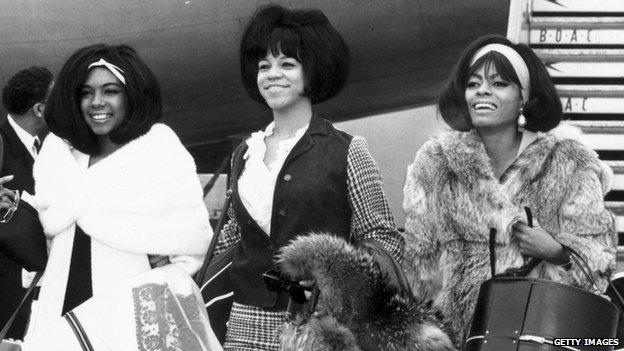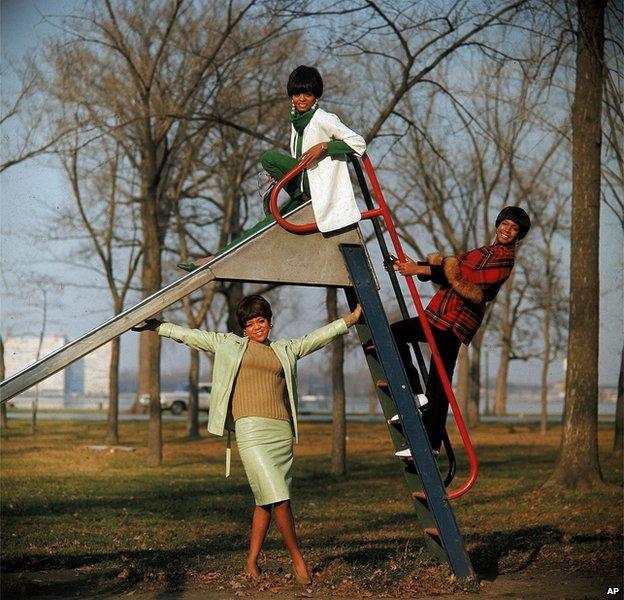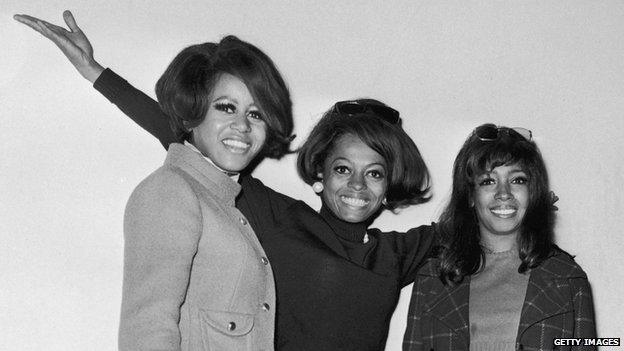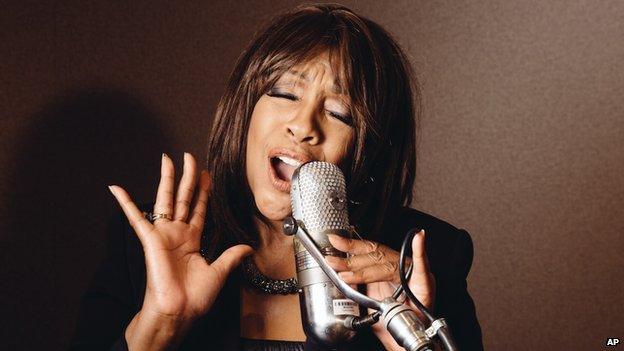Supreme star Mary Wilson celebrates 50th anniversary of first number one
- Published

The Supremes - (l to r) Mary Wilson, Florence Ballard and Diana Ross - arrive in London in March 1965
Fifty years ago this month, girl group the Supremes began an unprecedented run of success for Motown in the music charts.
With five consecutive releases hitting number one, the Supremes fought against the British invasion of the US music scene in 1964.
According to founder member Mary Wilson, though, the group was not just the glamorous hit machine people recall.
"If you're an African-American," Wilson says, "most people think you're going to sing R&B. Often that's true, but not with the Supremes.
"We were the group who proved if you were black, you could sing pop and still top the charts."
Wilson is now 70, lives near Las Vegas and remains in demand as a performer. Along with Diana Ross (to whom she usually refers as Diane), she is a survivor of the original Supremes line-up of 1959.
"It started in the Brewster-Douglass Housing Projects in Detroit," she recalls. "They've gone now and they had problems in later years. But back in the '50s, it was a huge park-like environment with high-rise blocks housing low-income families.
"You'd find people just hanging out in the streets, sitting around singing. Other people played football or basketball. When we were growing up, it was a fun environment to live in."
The Supremes were the creation of a Detroit group called The Primes who wanted a new girl group as part of a show package. The Primes later became the basis of The Temptations.
"It just so happened I'd met Florence Ballard at an elementary school show and we thought we should sing together," Wilson continues.
"A couple of weeks later, Florence ran up to me and said these guys wanted to put a girl group together. She'd mentioned me to them and said the guys were going to ask this girl across the street called Diane."
For a time Betty McGlown was the fourth member of the act, initially known as the Primettes.

The Supremes had their first US number one in August 1964
When the Supremes were given their first Motown contract in 1961, they were in their mid-teens. But success did not come overnight.
"We were still learning our trade," remembers Wilson. "Sometimes we'd be there just doing hand-claps in the studio, or we'd do little record-hop shows with different DJs.
"I think after a couple of years, Berry Gordy at Motown recognised we were getting more serious about our careers - it wasn't just a little hobby any more.
"So he put us with his best writing team - Eddie and Brian Holland and Lamont Dozier. And 1964 was the year it suddenly all happened for us."
It was also the year when British pop was taking America by storm. The Beatles were number one for 18 weeks that year, and other British acts topped the charts for another six.
"It was a monumental year for music, period," says Wilson. "There was a huge exchange of musical energy. The Beatles were massive in America, but at the same time Motown took off in the UK.
"Young people were looking for new experiences. We weren't all wrapped in our own little world the way people had been."
In August 1964 the group had its first US number one with Where Did Our Love Go. That was followed by Baby Love and Come See About Me, while the following year brought Stop! In the Name of Love and Back in My Arms Again.
To top the charts for a total of 11 weeks was a remarkable achievement at a time when the Beatles threatened to sweep all before them.
At first, Wilson recalls, none of the Supremes was happy with the material Holland-Dozier-Holland wrote for them. "We told them Where Did Our Love Go just wasn't us.
"But HDH insisted it would be a hit and they were right. They could tailor a song for, say, Martha and the Vandellas or for the Supremes - they knew exactly what suited which group.
"It was the same with Baby Love. We thought it was bubblegum music. We didn't like it at all - until it was a big hit.

After Florence Ballard left the Supremes in 1967, her place was filled by Cindy Birdsong (l)
"Motown knew we were basically a pop act. Vocally Florence was the most R&B of us, a bit like Etta James. I sang the cute little ballads and Diane had a pop voice.
"When Berry Gordy decided to build the group around Diane, that pointed the way we were going.
"It was the day of the girl groups: the Shirelles, the Chantelles, the Ronettes, the Dixie Cups. But it just ended up that we were unique in our sound and our look. We brought glamour to rock and roll."
Wilson is proud of the Supremes' effect on fashion: "You could say we defined what a girl group ought to look like.
"When people ask about those days, it's almost as much the frocks they talk about as the music. But that doesn't mean we were just glamour-pusses."
By 1964 America was entering a period of rapid social change. Just before the group's first number one, President Lyndon B Johnson had signed into law the Civil Rights Act, designed to end segregation and racial division in the USA.
"We have to look at the social environment in America. Don't forget at the same time that we were having number one records there were still people being murdered in the South for being black.
"But black people were moving forward in terms of equal treatment. It was a great idea whose time had come.
"Being black in America you were automatically involved in Civil Rights. The songs we performed weren't political - they were about love and happiness.
"But we became involved in politics anyway when we endorsed Hubert Humphrey for president [in 1968], and before that we were hanging out with Martin Luther King.
"The bigger you became as an artist, the more you became involved with the front-line fighting."

Wilson says it was "a once-in-a-lifetime experience" to be part of the Supremes' 1960s success story
Ballard left the Supremes in 1967 and died nine years later. From 1967 the group was billed as Diana Ross and the Supremes, but Ross left in 1970 to go solo.
The line-up continued to change, though Wilson remained as a Supreme until 1977. Her last performance was in London, at the Theatre Royal Drury Lane.
These days the singer avoids reminiscing too much: "I'm making an exception for the 50th anniversary of our big year. But by and large I'm more interested in today.
"I have a new record out, I've written two best-sellers and I have a gown collection which tours museums."
Looking back, though, Wilson acknowledges the 1960s "were an amazing period not just for America but for the world - how fantastic to have been a part of it. I think it was the beginning of an era of liberation.
"It was a once-in-a-lifetime experience, but I hope I always remained rooted in everyday life. I now have eight grandchildren and I tell my daughter I've been a pretty normal person all my life.
"She looks at me and says: 'Mom, you weren't normal - you were a Supreme'."
- Published19 July 2013
